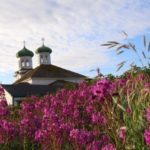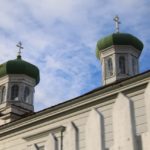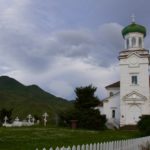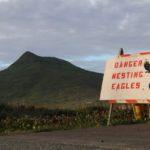5 August 2016.
This is our last full day in Unalaska. It is hard to resist the temptation to continue exploring the island, but today we must prepare and sort the material we have collected in nearly two weeks of the expedition. We set a working lab in the Grand Aleutian Hotel and begin sorting through hundreds of plant samples. The seeds are divided in three lots. The seeds collected here will fuel research in labs in North America and Europe. Who knows which of these populations we have sampled will hold unexpected secrets beyond the goals of this research trip. Josh and Jannice take hundreds of seeds to their labs, and I will transport the remaining of the seed material, leaves stored in silica gel, and herbarium specimens.
The herbarium specimens are prepared and pressed between sheets of newspaper, porous paper, and cardboard. The black straps of the wooden press, hold and squeeze the pants dry. The resulting flattened plants will lose some of their colours.
But their essence will be maintained in this dried form.
Once prepared a herbarium specimen can last hundreds of years; Darwin’s herbarium specimens can still be seen in the Natural History Museum in London. The plants we are collecting in this trip will be deposited in Herbaria in Fairbanks and Edinburgh. A herbarium is a plant museum that serves both as a record of plant life across time and as a source for teaching and research. No matter how many notes you take in the field, or how many photos you shoot, despite all the genetic analyses you may perform, nothing will replace the dried plant pressed between old newspaper sheets. Details of the morphology that were overlooked, characteristics that define a population or even a species are preserved in this herbarium. And herbarium specimens can now also be used as repositories of genomic information. Using genetic tools similar to the ones used to study DNA in ancient human and animal bones, one can extract entire plant genomes from herbarium plants. Thus an herbarium is not only an individual plant preserved dried in a museum for arcane research. It also holds plants across different time points (from Linnaeus to nowadays) and becomes an ark of biological material, both morphological and genetic, which will allow future researchers to study how life continues changing and adapting through time.
By the end of the day we have finished preparing the material. The room is quite and seed envelopes, silica gel, plastic bags, and boxes lay all over the place. The three of us are satisfied and happy to have found and collected Mimulus in this amazing trip. Since we started the trip we have sampled more than 20 populations. Not bad. Not bad at all.
In the evening, we stopped by Suzi’s house to drop off the leftover gas canisters and supplies, and to return her walking stick and leave one more that Josh carved in the fire. I take the chance to shoot a few more photos of the Orthodox Cathedral. The thought crosses my mind that I never had the chance to pass the regards from Father Methodious to the Unalaskan priest, Father Ivan. The fireweed (Chamaerion angustifolium) puts out its best display of pink flowers outside the Cathedral. In the river opposite to the road, the salmon struggle against the current, their back breaking the water, and sploshing across the stream.
As a farewell night, and invited by the volcanologists that we met at the hotel a few days ago we head to the local bar (the ones that travel by helicopter and who kindly have spotted monkeyflowers in other parts of the island for us).
The bar is called The Norwegian Rat.
A wooden house near the water, surrounded by crab traps and wooden pallets, and a WWI bunker in the corner outside. Josh decides not to join in, and Jannice and I head to the rathole, a bit uncertain of what the heir of the Elbow Room may hold for us. (The Elbow Room was an infamous and rowdy bar in Unalaska, but is now closed. The closure brought infinite happiness to Suzi Golodoff who happened to live next door to it, and had to endure loudness and drunks for many years). As we walk in a sign requests closing the door immediately to avoid being taken out of its hinges due to strong winds. I wonder if this is a code phrase to keep The Rat isolated from the outside. Inside, there are a few pool tables, a shuffle board, and a well-stocked bar… with stuffed animals and pelts hanging from the ceiling. The night was full of encounters with local characters and a few other scientists. Although it is hard to tell who is really local. The best Jannice and I could do is to look at their shoes. Brown rubber boots of a specific brand seems to be a unifying character of who we thing are locals. At The Rat we met Kurt a fisherman, who was having the “happiest nigh of his life”. Theo, a bush pilot who has just come from the Pribiloff Islands, two ex-marines who are doing some surveying of the Bristol Bay with a large crew of geoscientists, a large and drunk Unalaskan who enjoys throwing pallets into the open fire pit until an even larger barman comes to tell him off, Amy or Annie and his local friend who are gracious about us accidentally knocking their beer on the floor. In just a couple hours, The Rat gives us a small taste of what nightlife in a place like Unalaska may be. Boring is not.




